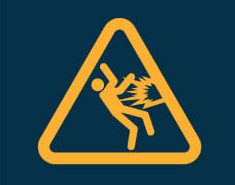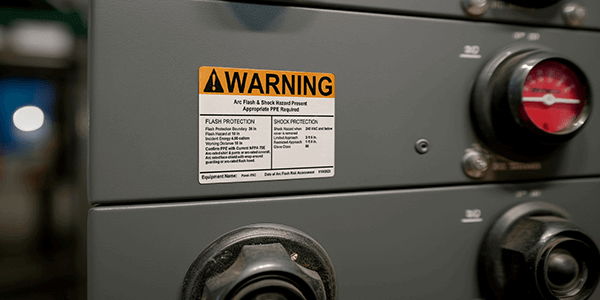Create a Safer Facility with a Proper Arc Flash Boundary

What Is the Arc Flash Boundary?
NFPA 70E is the major industrial standard for safe electrical work in the United States. It defines three protective boundaries around electrical equipment. One of the boundaries, called the Arc Flash Boundary, is based on the expected incident energy from an arc flash, and is intended to protect workers from burns if such an accident occurs. The other two are the Limited Approach Boundary and the Restricted Approach Boundary, which are based on the voltage of the equipment, and are intended to protect workers from electric shock.
In an arc flash, the most common and most severe injuries are burns. These burns are caused by the extreme heat given off by the runaway arc; that radiant heat spreads out in all directions, getting weaker as it gets farther from the source. As a result, NFPA 70E includes a "stay-back" distance intended to limit these burns. The Arc Flash Boundary marks the distance from the equipment at which the Incident Energy of an arc flash would be 1.2 cal/cm?.
While these injuries are serious, they are generally treatable, unlike the third-degree burns that would occur inside the arc flash boundary. Effectively, staying outside the Arc Flash Boundary is a way to limit any injuries from an arc flash to a treatable level. Staying outside this defined distance helps reduce the severity of injuries and strengthens overall electrical safety.
Arc Flash Protection and PPE Requirements
NFPA 70E defines the arc flash boundary as the minimum safe distance from energized equipment where a worker could experience second-degree burns during an arc flash event.
Staying away from the equipment is an easy way to keep safe, but sometimes a worker simply must get closer in order to do their work. In this case, the Arc Flash Boundary offers another, related benefit; it tells workers when they need specific gear. If workers must cross this boundary to work on the equipment while it is still powered, they need specific personal protective equipment (PPE) to protect them from burns. Failure to use the right PPE can lead to life-altering injuries.
The type of needed PPE will depend on the work being done, the nature of the equipment, and the available power. Qualified workers, who have the training to safely perform the task in question, should use the information on the equipment's arc flash label to identify the PPE they need. Unqualified workers, who may not be prepared to protect themselves to the same degree, should stay away; they should not cross the Arc Flash Boundary.
Electric Shock Protection Boundaries
Most equipment that poses an arc flash hazard also presents a risk of electric shock. However, the two hazards need to be addressed separately. The two shock protection boundaries are intended to protect workers from this second hazard.

The Limited Approach Boundary is the normal "stay-back" distance for unqualified persons (that is, people without any special training or equipment). Qualified persons, who have been trained and equipped for the task at hand, may cross this boundary, if needed. Qualified persons may also escort unqualified persons through the area, if appropriate protective equipment is provided for the visitor, as well.
The Restricted Approach Boundary is closer to live parts and may only be crossed by qualified persons. Crossing this boundary to perform work while the equipment is still powered also requires an energized electrical work permit, which includes a specific plan of action, a list of protective steps to be taken, and supervisory approval.
All three of the NFPA 70E boundaries are described in this Electrical Safety Boundaries infographic.
Calculating the Arc Flash Boundary
The two shock protection boundaries are based exclusively on the voltage of the equipment and can be found in a set of tables in NFPA 70E. AC systems are covered in Table 130.4(D)(a), and DC systems are covered in Table 130.4(D)(b).
Calculating the Arc Flash Boundary is more complex, partly because the phenomenon of arc flash is still being researched. There are three major methods for determining this boundary:
- NFPA 70E provides a simplified formula for calculating incident energy, based on the theoretical work of Dr. Ralph Lee.
- IEEE 1584 provides an alternative, empirically-based formula, which was developed through laboratory testing and was substantially updated in late 2018. This formula is widely held to provide more accurate results than the theoretically-based "Lee Method."
- For common equipment types and installations, NFPA 70E includes tables that assign Arc Flash PPE Categories and Arc Flash Boundaries. Table 130.7(C)(15)(A)(b) covers AC systems, and Table 130.7(C)(15)(B) covers DC systems.
Arc Flash software, such as Arc Advisor or EasyPower, can calculate Arc Flash Boundaries and perform many of the other tasks associated with electrical system analysis. For some situations, it may be better to contact an electrical engineering company to provide the necessary expertise. Whatever approach you take in your facility, be sure to post these boundaries and train your workers to understand and respect them. For practical advice on posting this information, see our webinar on Labeling for Arc Flash Hazards.
Keep your workplace safe with Arc Flash Labeling
Our free 130-page Guide to Arc Flash Hazards is the most comprehensive resource in the industry and gives you practical advice to reduce accidents and keep employees safe. Download yours today.
Related Resources

Arc Flash Protection Made Simple for Every Facility
What Is An Arc Flash Protection Boundary? An arc flash protection boundary defines the minimum safe distance ...
Read
Strengthen Electrical Safety Through Effective Arc Flash Training
What Electrical Safety Hazards Put Workers at Risk? Electricity powers the modern workplace. Motors, ovens, ...
Read
Safe Distancing for Electrical Work
In a recent Facebook poll, electrical workers said that work area and arc flash boundaries were among their ...
Read.png)





